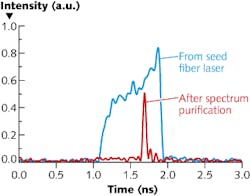Fiber-pumped high-power mid-IR laser produces picosecond pulse bunches
A high-power mid-infrared (mid-IR) fiber laser developed at Zhejiang University (Hangzhou, China) and based on quasi-synchronously pumping periodically poled magnesium-oxide doped lithium niobate (PPMgLN) achieves an average output power of 4 W at a 3.45 μm wavelength with a picosecond-pulse-bunch output. The laser could be useful for environmental monitoring, missile countermeasures, and medical diagnostics.
In the system, light originates in a linearly polarized master-oscillator power-amplifier (MOPA) ytterbium (Yb)-doped fiber laser emitting at around 1060 nm and with a picosecond-pulse output. This light enters a circulator and passes through a fiber-Bragg-grating (FBG) reflector, which narrows the pulse from an 800 to a 50 ps duration and from a 9 to a 0.15 nm spectral full-width at half-maximum (FWHM). A pulse multiplier consisting of looped, cascaded fiber couplers bunch the pulses into groups of 13 subpulses, which are then amplified by two-stage Yb fiber amplifiers. The 85 W output pumps a PPMgLN-based optical parametric oscillator (OPO) through quasi-synchronization, producing the final 4 W picosecond-pulse-bunch mid-IR output. The researchers hope to optimize the cascaded loop lengths to better than 1 mm, which should further boost the OPO efficiency. Contact Yonghang Shen at [email protected].

John Wallace | Senior Technical Editor (1998-2022)
John Wallace was with Laser Focus World for nearly 25 years, retiring in late June 2022. He obtained a bachelor's degree in mechanical engineering and physics at Rutgers University and a master's in optical engineering at the University of Rochester. Before becoming an editor, John worked as an engineer at RCA, Exxon, Eastman Kodak, and GCA Corporation.
